Chumba is a fairly small outfit hand-building gravel, mountain, and soon, road bikes in Austin, Texas. The Terlingua is their gravel offering, cooked up in both steel and titanium flavors, and we have spent the past two months putting the steel model through its paces. The Terlingua is a modern steed, built with stiff chainstays and downtube for efficiency; and more compliant seat stays and top tube for stability in the rough. Its head tube is 44mm to accommodate either straight or tapered steer tubes, and its bottom bracket shell is a traditional BSA 68mm threaded affair. The standard fork option is ENVE’s CX carbon with a 100×12 thru-axle, though several other options are available as well. Our test bike came dressed to the nines in metallic purple paint with clever logo panels that shift between black and white as the light changes. It’s available as a frame-only, frameset, or complete build with numerous customization options for components and frame details.
The Specifications
Our review bike came with Chumba’s “Build Kit 3,” with a few of their optional customizations peppered in for good measure. The (very thoughtful) build includes a surprising number of made-in-USA parts:
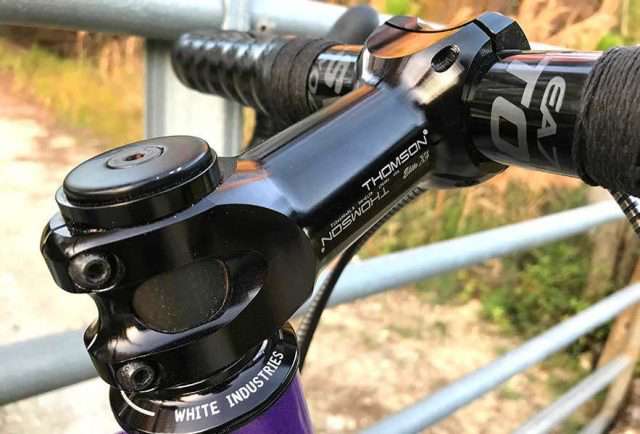
Pictured above, the ENVE CX carbon thru-axle fork (395mm axle-to-crown / 47mm rake / 100×12 axle) boasts clearance for up to 700c x 50mm or 650b x 2.1”, though geometry is optimized for 700c x 32mm – 42mm or 650b x 40mm – 50mm.
Above, 700c STATE Wheels 24mm carbon gravel rims laced to White Industries CLD thru-axle hubs.
White Industries R30 cranks with Tall-Short 42T chainring – Check out our long term review of the MR30 crankset with VBC chainrings.
Kogel bottom bracket and derailleur pulleys offer efficiency and durability. We have a Kogel bottom bracket in for review, watch this space.
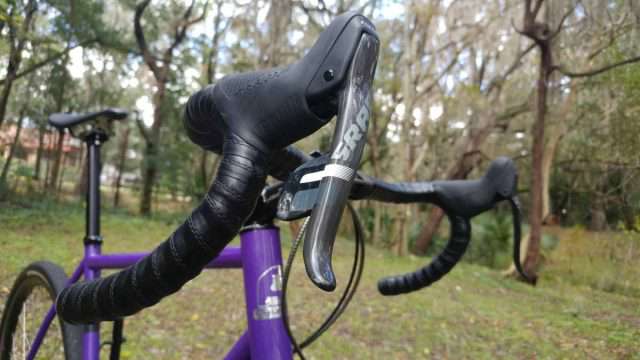
You don’t see these brakes too often. Yokozuna Motoko hydraulic-converting brake calipers paired to Shimano IceTech rotors. The Yokozuna units are a more elegant design than other offerings currently on the market.
Paragon Machine Works sliding 142mm x 12mm thru-axle rear dropouts. Keen-eyed observers will note the anodized titanium fixing bolts.
Manufactured in Macon, Georgia, the Thomson seatpost clamp and Thomson Elite seatpost nicely compliment the Thomson stem up front.
The Terlingua is one of the most versatile gravel platforms available, with a 68mm bottom bracket shell, mega tire clearance, and Q factor clearance for many cranksets, including both Dura-Ace and Force. Max chainring sizes are 46T (1x) and 52/38 (2x).
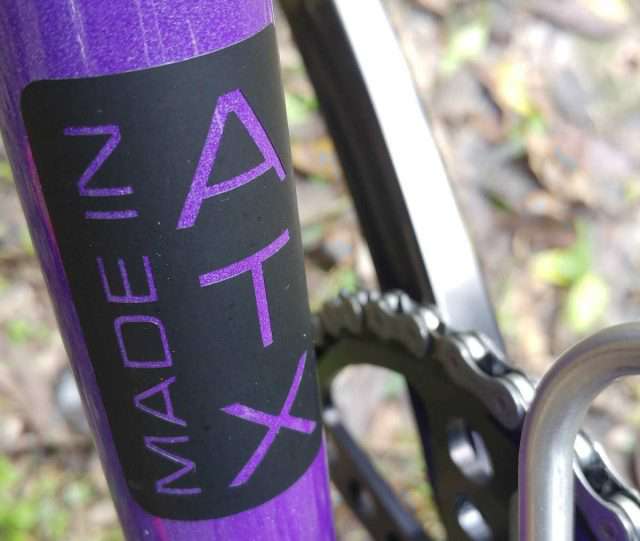
This bike can floss: Logo panels change color from black to bright white, depending on the light angle.
The custom anodized titanium bottle cages are by King Cage.
Above, Sparkle paint!
The Ride
Quiver Killer. A term that’s used a lot but means little. Because, of course, any bike can do it all. And because, of course, no bike can.
When I was a kid I had a basic-but-pretty-good mountain bike. I rode single track and jumped crappy makeshift ramps. I learned some trials. I raced more than a few crits, did some kilos on the velodrome, and finished a road century. And while I was aware of the existence of trials- and road- and track bikes, I felt like my mountain bike was perfectly good at all of the above. I think often about the way I identified with bikes as a kid vs. how I do now. These days, my partner Gaby and I have a guest bedroom piled full of bikes for all occasions. There are different shoes, helmets, gloves and jerseys for different bikes. It’s hard to imagine riding without chamois cream, let alone in Levis. You get where I’m going with this… Do we really need all this stuff just to enjoy an activity as pure and simple as riding a bike?
Hell yes we do. If you’re racing, that answer is obvious because while you can ride a mountain bike on the road or a road bike on singletrack, you’ll sacrifice quite a bit of efficiency in doing so. And what if you’re like me and you mostly ride for the joy of it? Well, many of us find that we enjoy more than one genre of the sport, so it’s easy enough to justify having equipment that helps us find maximum joy whether we’re riding road, crushing gravel, slaying singletrack, commuting, touring or whatever else blows our hair back. But there is a limit, right? And when we find ourselves wanting different bikes for two disciplines as seemingly similar as cyclocross and gravel riding, we might start to think we’ve crossed a line somewhere along the way.
A lot of us have used cyclocross bikes for “gravel grinding” for decades, and they’ve always worked fine. But the explosion of gravel bikes on the scene in recent years means we now have a lot of minor variations on the theme. Generally, you’ll find that “gravel” bikes have lower bottom brackets, longer wheelbases and greater tire clearance than “cyclocross” bikes. All of these differences have evolved as riders sought more compliant, stable and comfortable bikes for long distances on rough roads. Think of the difference between a criterium bike and an endurance road bike and you’ll pretty much have the right idea. Of course, these evolutionary traits have also made the gravel bike less adept at true ‘cross racing.
Enter the Terlingua.
Interestingly, Chumba have built this frame for a geared drivetrain, but also included sliding dropouts. Yeah, you could run it single speed if you want, but that’s not where the true cleverness lies: The slider dropouts allow for anywhere between 425mm and 445mm chainstay length. Pair that with a fairly high bottom bracket (68mm drop) and a slightly-slacker-than-normal head tube angle (71.5º on the 56cm size), and you’ve got a bike that can pretty fairly call itself both a “gravel bike” and a “‘cross bike.”
I decided to try it first with the rear wheel tukt (425mm chainstay). I like my bikes short and playful, and I’ve become accustomed to the industry’s search for compliance and the resulting tendency to create what I think are boring, lifeless bikes. My first impression aboard the Terlingua: This bike is NOT BORING. In ‘cross mode, it wants to go fast. It jumps out ahead of me, hops obstacles, and slings me through corners, encouraging me to give it more and more gas. When I get out of the saddle for a sprint, I almost have to pause and look back, because it feels like someone is pushing me from behind. Florida’s dirt roads are all very straight, though, and this bike is so spirited I’ll have to find some singletrack to do it justice. San Felasco and Santos trail systems here in North Central Florida will give me a wide variety of terrain to try it out.
On flat, twisty intermediate trails, I swear the Terlingua is faster than my trail bike. I’m giddily carving corners and dropping my riding partner on his MTB.
I’ve ridden these trails on my own gravel bike, and while it was fun, it was also plenty sketchy. The Chumba is not. It pushes me onward. There are some small root- and rock drops and the Terlingua loves them. When we get to the Vortex area at Santos and its many dirt jump lines, I have to remind myself that I’m on a borrowed steed and reluctantly pass them up. This bike is eager and cooperative and happily spits the trail out behind me. It is — and I say this un-ironically — shreddy. I have to imagine it would hold its own against any top-tier race bike in a CX field, and it might well be more fun.
So what happens if I move the rear wheel all the way back in the dropouts (445mm chainstay)? A 5mm hex key makes the adjustment, and the Chumba and I get back into some longer dirt-road rides. The rocketship effect when sprinting is lessened somewhat, and the 2cm longer wheelbase obviously slows the handling, but these changes are more subtle than I expected. The most noticeable effect is that the Terlingua now feels like the kind of bike I could ride with no hands through a rock garden while texting. It’s really stable. While I do tend to gravitate toward playful bikes, it’s true that this kind of stability is a huge plus when you’re spending several hours at a time in the saddle; especially on unpredictable terrain. In this mode, the bike says, “Relax. Sit up and stretch your back a bit. Fumble with that package of Lance crackers you got at the store stop. I’ve got this.” The bike has put me in the passenger seat, and on a long ride, I’m just fine with that.
Have Chumba delivered on their promise of creating a single bike with class-leading performance as both a cyclocross- and gravel bike? I think they have. And it’s not as easy as just slapping different wheels or some sliding dropouts on a bike of one kind or the other. Chumba has combined all the right details here to achieve a pretty elusive feat: The Terlingua’s relatively high bottom bracket, slightly slackened head tube, true CX fork geometry, adjustable chainstay length, and super-versatile build options combine to form a unique machine. The result is a bike that actually is equally at home in an endurance event or carving up hairpins and hopping barriers. Not only that, but this bike’s ride characteristics vary so much with an adjustment of the rear dropout that it should suit just about anyone, regardless of a rider’s preference for stability or shredy-ness. It’s not often that I find it hard to criticize a bike, but that’s the case here. Any nits I have to pick are limited to individual components (the shift paddles of the Force shifters tend to catch and stick on the Easton handlebar’s drops) and Chumba offers enough build options to remedy them. The verdict: Chapeau, lads.
Many thanks to our guest reviewer, Michael McAleer, for his hard owrk on this review.
Chumba Podcast with The Gravel Ride
In this cooperation with our friends at The Gravel Ride Podcast, Craig interviews Vince Colvin, one of the key players at Chumba USA.
You can also find The Gravel Ride on iTunes and Spotify.
Chumba Podcast Transcription (please forgive any errors)
Vince, welcome to the podcast.
Well, thanks for having me.
Yeah, I’m excited to get into it and learn a little bit more about Chumba USA. But first I always like to start off by learning a little bit more about you as a cyclist, what your background is.
Oh, for sure, man. I’ve, since college started, started I guess back in 2002, got really into believe or not like more urban riding as you as you would when you go to school, but then quickly fell in love with mountain biking. And, , I think every bike that I started off with was probably single speed and, , a lot of fun. And initially they’re just building up all the bikes myself. And, , what was interesting is I was in school so I didn’t have any money and , by methodology behind everything was like, all right, well as long as I continue to build bikes and ride them, I’m going to force myself to learn how to do everything there is to maintain them and never take my bike to a shop. , and so I started out doing that and went through from, you know, building a bike from scratch, building the wheels to, , breaking all kinds of stuff and writing all contents of different bikes.
And where were you doing that?
It was all in, in Richmond, Virginia initially. So I was going to, Virginia Commonwealth University and I was doing a bunch of like, a bunch of work with their outdoor adventure program they’re doing out there, leadership classes and leading trips and like Whitewater kayaking, rock climbing, , , that back country hiking, all that kind of stuff. So just being outside was like really important and you finding bikes as a way to get farther out into spaces was even early on, a lot of fun and kind of help develop my passion for it overall. And then everywhere I’ve moved since I’ve always just a boy, he’s just written, obviously everywhere. We’ve gone a long time up in Philly and then down down in Texas. I’ve been here about nine years now.but when I was in Philly, I was also working in shops while I was also in graduate school and then I worked in shops here in Texas for a while managing a shops and then transitioned over to working with Chumba.
How long have you been working with the team?
So I’ve been here, , about five years now. And, , I, I was brought on early on, , from, from when our friend Aaron, , purchased the company, , to help him rebrand and recreate all the new designs that we have. , so about five years I was working in a bike shop managing that, , in a local area. And he, he brings some bikes by for me to check out. We just started talking and started collaborating on ideas, would come by and get my opinions on things. And then I quickly, we kind of developed a relationship and he invited me to come on and help them kind of get, get things going. , and then what’s interesting is, , you know, mark our frame builder myself, , over time. And like we, we developed a really, and, , last year in April, , our families, , and our, and mark and I got together and we actually purchased a Chumba and wonderlust gear from Erin. And so now the four of us, mark, myself and our two wives more, Michelle, , are run and on both companies.
Awesome. So the Chumba brand, it goes back prior to that five years. When did it originally start?
Start originally like in the 90s. , and interesting thing about it is Chumba has previously had like a, you know, a reputation for like big, burly, like downhill mountain bikes and they certainly had a huge involvement in the development of that end of the sport early on. , but what’s interesting is like the very, very roots of the company, , we’re amazing, , making all custom bicycles. So, , you know, when we took over the company, like I found design files for cross bikes and commuter bikes and track bikes and rode frames during bikes, like, , all types of things. , and doing more research just found that, you know, early on it was more about just making a whole range of, of options for people. , what’s kind of cool and like where we connect to their original story of the company is just that, you know, the initial owner and a founder of the company, I tend to annoy, , he was making everything , here and the in the US and one of the guiding principles of the company early on was just to make really durable product.
, and everything was raised, tested by team. So real world tested in actual applications where the bike is meant to be written. I’m just having a really clear understanding of what the use of the bike was going to be in a clear understanding of , kind of the forces and forces and kind of the writing goals, the people who are going to exert onto the bikes to make sure they’re going to perform over a long period of time. So we’ve kind of connected to that and tried to maintain that approach. , you know, that company eventually moved, moved to some overseas market as a, as Ted sold it to one of his other employees. , and we’ve, you know, obviously completely done the opposite and brought it all back to a in USA and, and Baden now’s manufacturing.
So that first sort of set of products that you guys introduced, was it the hard tail mountain bike side of things?
Yes. So when I first came on, we were working on the Ursa, which is 29 plus bike. This Stella, which is a 29er, , at the time, 27 to 27 plus wasn’t even a thing.and then the Rastro, which was like a long travel, aggressive hard tail. , and, , we kind of launched the company with those three bikes is like the foundation, , our team, our riders and ourselves, you’re realizing shit. And, , mountain biking, , durance racing cross country. , and then we quickly developed a, just, you know, my background from all the years working in the outdoor industry also, , getting really interested in bike packing. And, and our team was really pivotal in that, like especially with the launch of the, the earth, the twin add plus back early on we had a team writers take it overseas to , to Iceland’s early on and do like a huge trip to get feedback on a prototype. , and then we quickly just kind of saw the value in, you know, product testing that way to put the bikes. So you’re really hard challenging like ultra race events or backpacking trips just to get feedback from the riders. I mean you spend there really extended amount of time, like continuously on one bike. , you can really easily sauce out the, the good qualities and bad qualities and improved prototype versus just like a ride here and there.
Yeah, that was one of the reasons I was really excited to talk to you today because I feel like a lot of the conversations I have around gravel cycling, we’re talking about bringing road cyclists into gravel and Chumba as a company. It’s clear from your roots is so much on the mountain bike side in the bike packing side, which is how I yeah, and that’s how I originally got interested in the notion of gravel riding. I was following a lot of the big bike packing races and just really intrigued by adventure riding in general. , that gravel riding just kind of fell out of that passion. I wasn’t able in my life to carve out a lot of time for bike packing trips, but I was able to, you know, hit the dirt every day. I ride a bike around here and grabbing a gravel bike just made it more exciting and enabled me to link different trails and roads together that made everything in my backyard seem new again. Given that MTB influence, when did gravel bike frame design start to come into play for Chumba and what did it mean? Obviously not coming from a road plus perspective, you’re coming from a kind of a, a downsized mountain bike perspective.
How did it influence the design of the Terrlingua?
Well, it’s, it’s Kinda interesting because I mean, well it does have, while we do have like our roots as a company and not bike, , heritage and design, , mark, our frame builder was a long time, , custom road builders as well. And then we all also ride road. So, I mean, it’s not like a totally foreign thing to us, but what’s unique, , coming from us in this way is like a lot of companies that are like a mountain bike company that moved into, I grappled like design, they don’t always do it with the homework. Traditional cyclocross, excellent crown on the bike. , we really wanted to make a bike that was a tried and true gravel bikes could kind of performing like a wide array of things. We didn’t want to make a mountain bike that you could write on it. Travel. We felt like we kind of already had that, , with the Stella, like if you want a flat bar gravel bike, you can, you can do that.
We wanted to make a real, , in our opinion you know, are real gravel bikes, you know, suited for use of drop bars and a traditional axle crown on a fork, , versus just like a, a total monster cross, , type of vehicle for someone to use. , so in terms of where the design concept came from, , we had so many of our team riders specifically requesting a one bikes that they could train on for the mountains, season bikes that they could raise cyclocross on bikes so they could raise gravel events on. , we’ve seen just a huge trend, you know, with customers and ourselves and, , you know, initially like just feedback from the team that, you know, people wanted to spend less time training on the road, more time, , getting lost on gravel roads and taking advantage of, , all the new tire sizes that were coming out and they wanted to do it on a bike that was, you know, built around it.
So initially it came out as like, well, I mean our team is asking for this, which is usually a good sign that customers will also respond and, and, and want to see it. So, so that really the initial need for the bike kind of came out of, of the team requesting it to be made. , then we definitely start seeing like a, an increase in customers. Like just, just mentioning it like, Hey, when are you guys going to do this? Like, is that going to happen? Like, would this be a thing? And, , it just kind of fell into place that it would be natural for us, , to do. , but what’s fun is that we definitely, like, I could definitely speak towards, you know, where the actual mountain bike influenced falls into the design of the bike. , there’s a couple things in the, in the bike itself that really kind of stand out to me.
, you know, one’s the head tube angle too, is the compatibility of the bike. And then three is really the tube selection and some of the angles on the bike for how those tubes are joined together. , so we designed the bike. If you look at gravel bikes in general, like across the spectr , you’ll find that most of the gravel bikes are slightly steeper head, same head to with than our bike. , you’ll find that most of them have a longer chainstay lanes and probably lower bottom brackets. , so we used a, a sliding bottom bracket that will allow you to have, , basically what, what would be considered like a short cyclocross links change day. , however you can also slide it backwards and get, you know, as long as some of the longest gravel offerings out there. So if you want the bike to be stable and fit really big tires that can do that. If you want it to be fast and snappy, like a cyclocross bike, , you can do that as well.
How does that actually work, Vince, on the bottom bracket to enable your, you to move that crank set?
So the, the crank said stays stationary, but the dropout itself slides forward and backward.
Gotcha. So it’s in the rear in the rear dropout where all that movement occurs.
Correct. So we use a stainless steel paragon machine works sliding dropout. , the idea is that, you know, you could make the bike singlespeed but also, you know, it’s really there so you can add tire clearance, you know, as you move that, , that wheel or that axle rear word, I know you’re going to gain additional clearance for larger diameter tires as well as well larger, , with their girth of attire as well. , so really trying to build, , build compatibility into the bike. And that’s something that, , on a bound like side is like so important. And I think that it’s been kind of a mess and the gravel industry so far that you’re seeing people catch up on him. You know, it was mountain bike builders. We’re, we’re having to build a bicycle that will effectively work in an extremely wide range of terrains, conditions, ride styles, , or, or different areas of the country or the world.
You build a road bike, well really you’re building a road bike to ride on pavement. , you know, and you, you’re obviously good. There’s going to be some, some variations obviously. , but not like the level of variations that you’ll find a had been bound industry grab what kind of sits to us, like kind of in between because you’re going to have customers that’ll never run anything bigger than a 32 she tire. And then you’ll have people who never run anything smaller than a 44. , and if you can give them a bike that can, can, , can not only be compatible, both those things, but also well with both of those things. , then you’ve, you’ve hopefully giving them a bike that is very versatile and they could ride, you know, and in Texas, but then also take on a trip and then ride, , in the specific northwest or you know, really anywhere in the country and, , handle a different terrain and be able to do, built towards that.
Right. That’s interesting. It does give people from the road side a lot more to think about in terms of adjustability. Then maybe something on the mountain bike side to someone. It might be more familiar with those type of options.
Yeah, I mean, I’m on a mountain bike, , you know, like on our 29 or for example, you know, you can run everything from a 27.5 inch tire up to like a two, eight or a 3.0. And then on the 29 side, people run anything from like a 2.1, two, three, five, two, four to six and even a two eight on some of the bikes. , so mountain bikers are used to seeing and kind of expect that level of compatibility with the bikes. And I think longterm you’ll see more gravel riders like kind of a proving of designs that better also as compatible for giving him lots of tire options so they can kind of plan for weather conditions or course conditions are different terrains.
Yeah, absolutely.
Gravel, the gravel, leave it in a given, even in a given state. I mean it could be completely different depending upon the road that you’re on. So it’s not like a, you know, a typical trail condition where it’s pretty consistent throughout a certain, a geographic location.
Yeah, I think that’s absolutely true. And even different times a year in the same region can, can warn different tire widths. Speaking of that, Vince, what is, what is that range of tires you could run? I believe you can run both 760 50 be the terror lingual, but what are we talking about for entire range?
Yeah. I mean we kind of have a, an optimized, , area, but it’ll, it’ll do up to a, a 50 see tire a or a 2.0 on the steel version and then up to a 2.1 on the titanium version. So the tire’s going to have a little bit more frame clearance from the tire, then the steel and then , both who work was six 50 be tires or 700 CE. So we do try to like suggest like 700 between like 32 and 44 is pretty optimal on the bike and for 600 TB, , you know, 40 to 50 c is really, really optimal on the bike. And , you know, it’s important to like when you’re making a bike that has so much versatility to also provide some, , you know, context as to like where the bike’s gonna perform. , so you know, we’re not in, should making it bike, that’s just meeting like a compatibility standard. We want it to still be optimized for doing its duty as a, as a race bike.
Yeah. I think that’s one of the interesting things as a, as a gravel bike owner, you really do need to think about what are you trying to optimize around cause it can, the bikes can feel very, very different. Even on even the same frame platform. You can make it feel very different depending on your tire setup and everything else you have going on. Right. I think I interrupted you a little bit when you were talking about the head tube angle and your decisions around there and the net effect of how the VI candles.
Yeah, for sure. , you know, we, we recognize also the gravel writers are often going with a little bit wider bar or at least with a bar with more flair on the bar. And as we’re seeing that happen more and more, we kind of felt like it was an opportunity to take advantage of, , looking at just like the overall head tube angle trend in the industry and then maybe going a half degree, , or you know, on certain sizes, slacker then, then the norm that you see. , and it’s worked out really well in our favor because , the bike then to us is a set up, much less like a traditional road bike where traditional road bikes not really designed to go bombing down really loose a gravelly downhill chunky terrain and washboard mixed in. That’s, that’s more like what sounds like, what about bikes built for?
, so we’re kind of landed is like something a kind of more in between the two and a, it helps to provide some stability on the bike, but I’ll also to work better with some of those wider bars or sweet bars. , we certainly see most majority of people still building the bike, , with about anywhere from like a 90 to 110 millimeters. Stem is typical across all the sizes. Almost all of our customers do a a hundred or a one 10 in most cases, smaller sizes, occasionally at 90. , that’s pretty typical for us. So we were still want that bike to be, you know, kind of weight forward and have a have weighed on that front tire to really be able to corner it aggressively. , and not just wash out under year or anything like that. , but we don’t want to have to run like a, a really short stem and along axle or crown to, to make the bike, , , you know, feel, feel different, you know?
Right. And have you spent enough time on flared bars to kind of give our listeners a little bit of understanding of what they are and what the effect of, , adding them to your bike would be?
Yeah, I mean, , personally I’ve been riding the eastern, , is 70 acts bars with a 16 degree flair, , for probably a little over a year now or close to a year. , you know, it to me it definitely does a couple things. One, if you’re a bike packing, you know, it could obviously just kind of open up a more relaxed hand position. , but really what it does primarily that I’ve noticed the most is it just provides a little bit more of a stable position, , which than a traditional road bar where you’re directly underneath the hood. ,
it’s ability in the drop position. Yeah,
correct. Yeah. The Hood, you’re essentially in the same zone. There’s obviously a lot of bars on the market where, you know, you’ll see the hoods kind of at a very nontraditional angle and then you’ll, you’ll have a really dramatic sleep in the bars. I think those can work really well for certain writers and certain applications. , personally I’m not a huge fan of them. , we do build with them from time to time. Just as you know, people’s personal fits require that or their intentions for what they want to do with a bike are, , those are really good options for getting into like a handlebar bag. You know, where the, you know, you’re getting more of an opening to get to the, to get to the handlebar role or, or into a harness and have more capacity on the bar. , but for writing applications, , you know, kind of a more traditional bar, , with, with some flair, , it was going to be kind of a great way to go.
, you know, with a 16 degree flare on the bike, I don’t really feel like you’re giving up a lot of what you would be giving up on like a true traditional road bar in terms of like power output, but you’re really increasing the mass stability on the bike and just getting a little bit more, , leverage really over corners. , and, and allowing you to not have to run like a, a really long stem like, , you know, one 20 or one 30, like a, like a more traditional road bike ticket that weight up on the front of the bike. Right. Because typically those flares are also going to, , increase the overall width compared to, , you know, your hood. The hood with at the bar is really based around.
Yeah. Yeah, absolutely. Cool. I appreciate that. I’m actually, I’m curious to try a set of flare bars out on my next bike for sure. So let’s, yeah, let’s try this. And I’ve been riding, riding, you know, more of have traditional road bar since got no flare whatsoever and I’ve demoed a few bikes with flares and I think it’s clearly the right way to go for the type of riding that I enjoy.
Yeah. I think that 16 degree is a great starting point to make that transition and give, give enough kind of experience to see if he would want to go further. , but it’s not such a huge j p that it would feel unnatural to someone who’s used to riding a regular drop are.
Well, let’s transition a little bit and start talking about frame materials. Cause I know you work in both steel and titanium , so as people are evaluating the selection of one of your frames, how do you, how do you guide them between those two choices?
, well it’s interesting because some companies really positioned it like one is really clearly better than the other and up their titanium frame it as a higher quality than the steel frame. It’s really not the case with our company. , both of the bikes are really at the same quality. It’s just the materials themselves are more expensive on the titanium bike. So it kind of boils down to obviously price point for certain people. , but it really comes down to two, the bad quality and kind of what your expectations are because to have the bike, , perform as, there are a few advantages on the tie in terms of getting, , additional, , tire clearance on the bike. But other than that, they’re really, , you know, physically very much, very much the same bike. , in terms of ride quality between the two, we get this question all the time is, you know, like how does it tie compared to the steel?
Is it going to be a harsher ride or a stiffer ride? , and it’s interesting because we designed both the bikes to be really compliant in the situations where you want them to be compliant. , but really all of our bikes, including the mountain bikes, they’re all designed to be really powerful platforms that you can still raison. , and to us, what that means is if you’re standing up and trying to do a sprint on the bike, that you’re going to feel like your efforts are being transferred into the frame, , that you’re not going to feel the bike, , swaying side to side like a noodle or an ultra light, a steel bike, you know, from, from, , you know, your days as a road cyclist on old, old steel road bike. , we’re trying to make bikes that are compliant as you’re writing them in kind of rough conditions and then powerful, , for the remainder of the ride.
, and what you’ll kind of feel typically is that the titanium s obviously going to be a little bit lighter than the steel. It saves between, you know, 0.75 lbs and a pound, depending upon the frame size that you’re looking at. , especially around the mountain bike, she’ll save, you know, sometimes even more depending on the size of the gravel bike. Usually about that much though. And what you’ll kind of see is that the titanium kind of has a little bit faster return to the material. So as you’re coming out of a corner and putting down power on the bike, you know, you’ll feel, , you know, really connected to, to the ground, , because you are getting some of that compliance in the frame. , but you’re going to feel your, your efforts transferred back into the bike really quickly. , whereas on a steel, you know, you’re going to hold onto that, , more compliance or simple feeling for just a little bit longer. , and for some people that could, , that could make the difference in like a long endurance ride. You know, compared to riding a, , like a carbon or an al in bike,
two teeth, similar performance across your entire size range. Are you guys making adjustments to tube diameters and different details in the tubing
on certain models of bikes? We do on the Terlingua we do on , the steel, the different, but sizes, all of the, yeah, all of the chair language uses same diameter overall, , of tubing. But we do do different sizes depending on, on the, on the rider says, and then we also do a different bottom bracket height’s a or drops, , depending on size as well to kind of be catering more to the individual sizes that are typical to run a different crank arm lengths on each of those sizes versus just having one broadly across the whole lineup.
Gotcha. I’m was always curious with everybody I talk to, to learn more about the rides that they have out their front door. So what’s the gravel cycling like around Austin
and Austin itself? There’s not a ton right here. , but if you get on a bike and ride in any direction for half an hour, you can find, so we have an enormous gravel community though and throughout Texas, really within an hour and a direction, there’s literally, you know, miles and miles of gravel roads to connect together. So on any given weekend you’ll have one to two credible events happening at the same time. , and there’s, there’s just a ton of stuff here to do really. You know, Texas itself just being so rural and so many areas of it lends itself to having a lot of country roads and low traffic scenarios to, to get on. So
generally speaking, is that suggest sort of a 700 c by 38 kind of set up for that kind of riding or would a different tire selection be?
I mean, it’s really very subjective. I mean, we, , we do a yearly gravel event here that we titled Sponsor, which just happened last weekend and I wrote it, , and on the road saw, you know, really every possible tire size out there. Like I wrote, it was a 32 see on mine too, the same tires. I use my bike whenever I’d cyclocross. And then I saw other people out there, like a lot of people with 44, 38. I mean, it’s, it’s a, everybody is trying to find what’s going to be optimal for them. And that’s what’s so interesting about this format too, is that it’s not a, there’s no like cut and paste answer where it’s like, this is gonna work for everybody. It’s more like you’ve got to find what’s gonna work for you and get that balance of traction, comfort. And , what’s interesting too is that, you know, , your riding position on the bike and really dictate how some of the different tires are gonna perform too. So you’ll see a lot of, , gravel cyclists, , setting up their bikes, like really neutral or more upright sometimes. And maybe leaning towards using a larger tire to kind of get traction back up front. And then, you know, typically you’ll see writers that are neutral and you know, with, , with negative drop on the bars, maybe going with a smaller tire because they don’t feel like they need that connection to keep the attraction up front. , there’s all kinds of different options.
Yeah. I always feel like there’s, you know, there’s, there’s gonna be some shortcomings in any set of you have in any given event, and that’s a great thing. So you’ll have writers who have gone big tires all day who finally get there, retribution on some massive downhill at the end of an event while they’re, while they’re staring longingly at someone who’s got a super lightweight 700 c by 32 on a climb.
Right. Yeah. I mean, there’s, there’s definitely moments where either writers going to be happy to, and the other one, and it’s always, it’s always fun to, to reassess what you brought on the way home from Morocco.
Exactly. Well, Vince, I really appreciate the time and I encourage everybody listening to go over to the Chumba USA website. I’ll put a link to it in the show notes. The guys do a good job of putting some videos up there and giving you a flavor of how nicely all these bikes are, connect, , constructed.
Oh, thanks. Yeah, we definitely appreciate the time and encourage people to give us a call on chat or shoot me an email. If you call her email, you’ll be talking to me and I’m happy to answer questions on just about anything on the bike, so, yeah.
Perfect. Thanks, Vince.



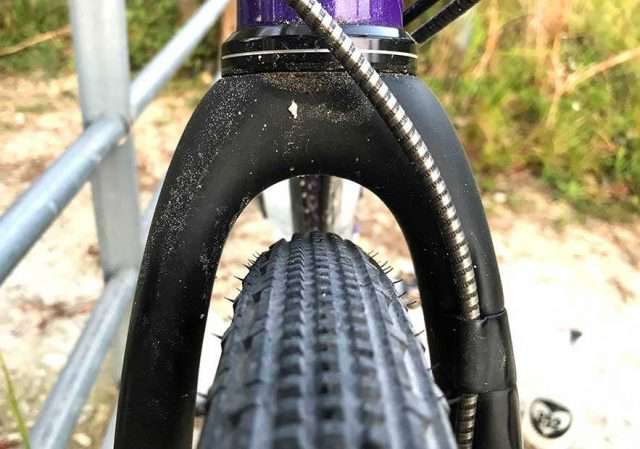
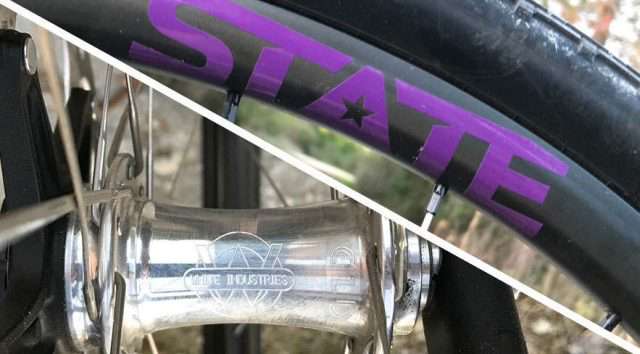
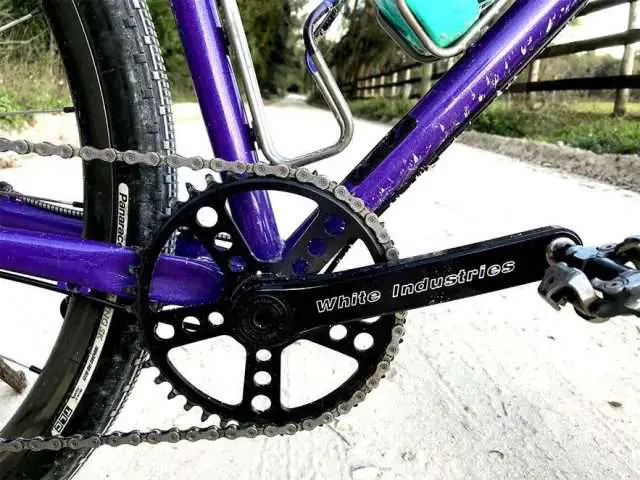
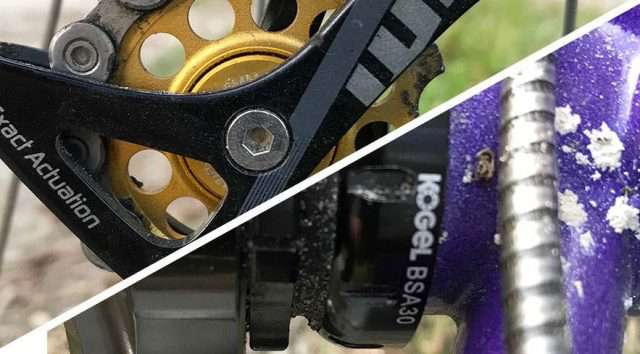
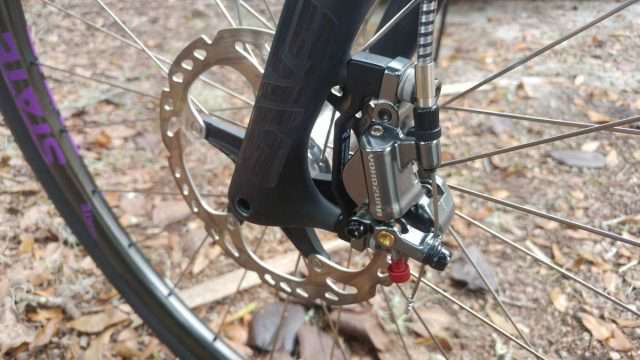
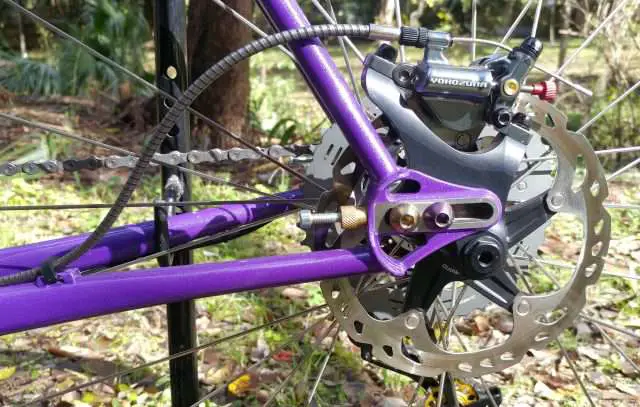
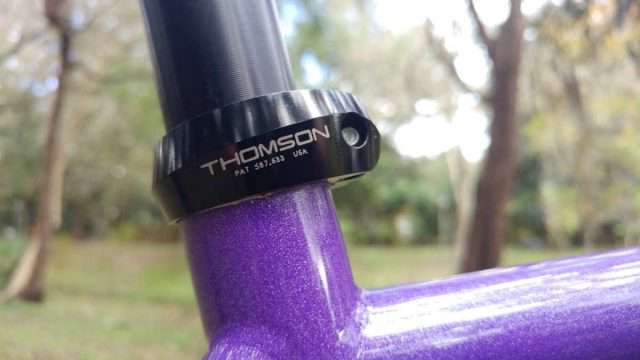
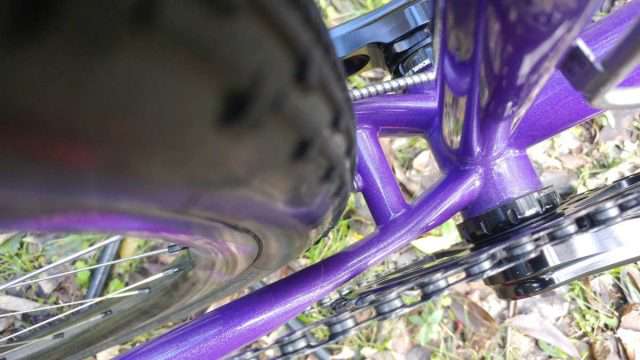
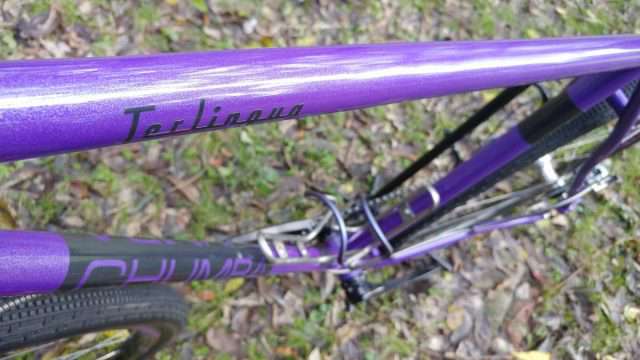
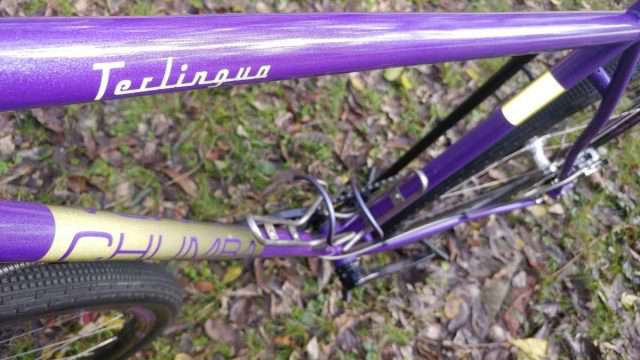
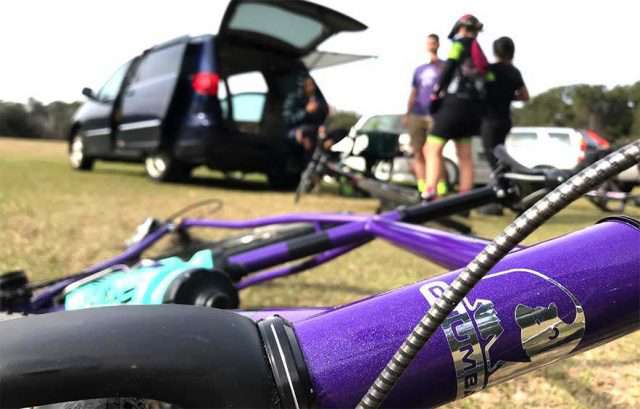
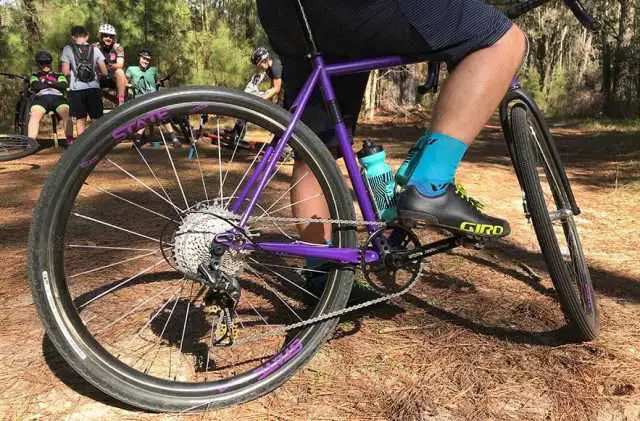
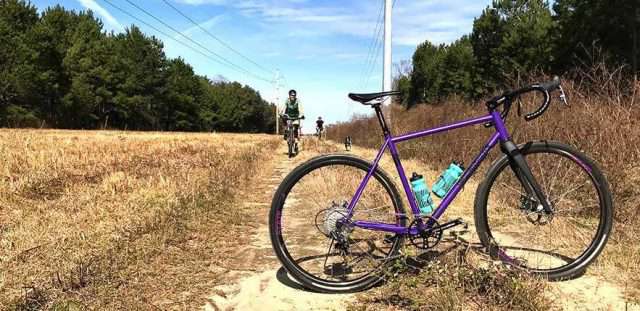
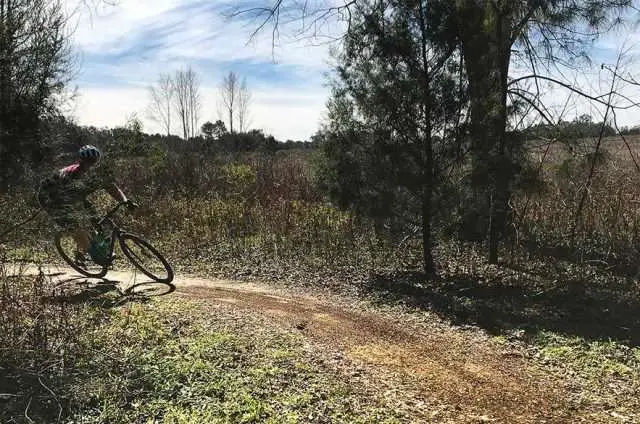
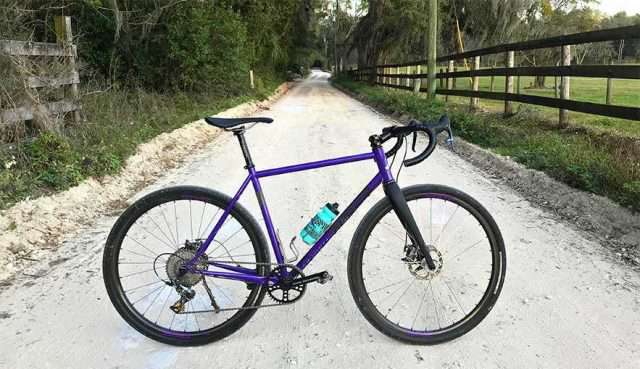
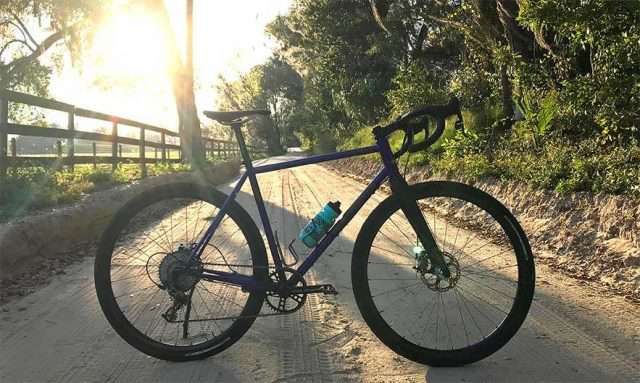
Nice bike. I own a similar custom built steel gravel bike with 160mm post mount Motoko calipers. I’ve been running the Motoko’s for nearly a year. Not quite as powerful of finely modulated as a full hydraulic rig; but they are at least a pound lighter, and very easy to maintain.
Trying to understand how/why “the shift paddles of the Force shifters tend to catch and stick on the Easton handlebar’s drops” since I’m interested in this setup too and from the picture I cannot envision it. Any more info?
Brett, I’ve found this to be the case with SRAM shifters and a few different handlebars. If (with your chosen brake setup) you’re able to pull the brake lever nearly all the way to the handlebar, the shift paddle behind the brake lever may catch against the side of the drop and stay there when you release the brake lever. It’s not a common occurrence, and only means that you have to push it loose from the bar with your finger before you can shift. Certainly not the end of the world, but it can be annoying. It can be remedied with a brake adjustment to keep the levers from reaching the bar.